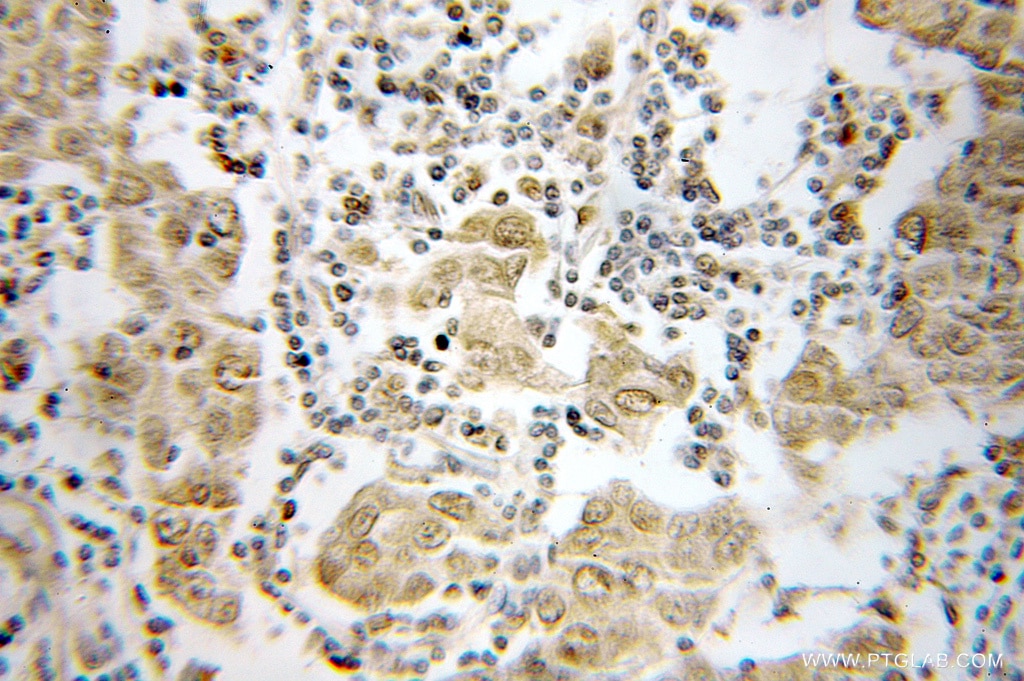- Phare
- Validé par KD/KO
Anticorps Polyclonal de lapin anti-PSMB4
PSMB4 Polyclonal Antibody for WB, IF, IHC, ELISA
Hôte / Isotype
Lapin / IgG
Réactivité testée
Humain, souris et plus (2)
Applications
WB, IHC, IF/ICC, ELISA
Conjugaison
Non conjugué
N° de cat : 11029-1-AP
Synonymes
Galerie de données de validation
Applications testées
| Résultats positifs en WB | cellules HEK-293, cellules MCF-7, tissu de muscle squelettique de souris, tissu de muscle squelettique humain, tissu placentaire humain |
| Résultats positifs en IHC | tissu de cancer du sein humain il est suggéré de démasquer l'antigène avec un tampon de TE buffer pH 9.0; (*) À défaut, 'le démasquage de l'antigène peut être 'effectué avec un tampon citrate pH 6,0. |
| Résultats positifs en IF/ICC | cellules MCF-7, cellules HepG2 |
Dilution recommandée
| Application | Dilution |
|---|---|
| Western Blot (WB) | WB : 1:2000-1:10000 |
| Immunohistochimie (IHC) | IHC : 1:20-1:200 |
| Immunofluorescence (IF)/ICC | IF/ICC : 1:20-1:200 |
| It is recommended that this reagent should be titrated in each testing system to obtain optimal results. | |
| Sample-dependent, check data in validation data gallery | |
Applications publiées
| KD/KO | See 2 publications below |
| WB | See 5 publications below |
| IHC | See 1 publications below |
| IF | See 1 publications below |
Informations sur le produit
11029-1-AP cible PSMB4 dans les applications de WB, IHC, IF/ICC, ELISA et montre une réactivité avec des échantillons Humain, souris
| Réactivité | Humain, souris |
| Réactivité citée | Humain, porc, singe, souris |
| Hôte / Isotype | Lapin / IgG |
| Clonalité | Polyclonal |
| Type | Anticorps |
| Immunogène | PSMB4 Protéine recombinante Ag1500 |
| Nom complet | proteasome (prosome, macropain) subunit, beta type, 4 |
| Masse moléculaire calculée | 29 kDa |
| Poids moléculaire observé | 25 kDa |
| Numéro d’acquisition GenBank | BC010088 |
| Symbole du gène | PSMB4 |
| Identification du gène (NCBI) | 5692 |
| Conjugaison | Non conjugué |
| Forme | Liquide |
| Méthode de purification | Purification par affinité contre l'antigène |
| Tampon de stockage | PBS avec azoture de sodium à 0,02 % et glycérol à 50 % pH 7,3 |
| Conditions de stockage | Stocker à -20°C. Stable pendant un an après l'expédition. L'aliquotage n'est pas nécessaire pour le stockage à -20oC Les 20ul contiennent 0,1% de BSA. |
Informations générales
PSMB4(Proteasome subunit beta type-4) is also named as PROS26 and belongs to the peptidase T1B family. The proteasome is a multicatalytic proteinase complex which is characterized by its ability to cleave peptides with Arg, Phe, Tyr, Leu, and Glu adjacent to the leaving group at neutral or slightly basic pH. The human protein PSMB4 is known mainly as an interaction partner for several proteins, suggesting an important function of binding not only to the lid, but also to the 20 S core of the proteasome. PSMB4 might be a major site for proteasome regulation, where signals from the outside might be transduced to the protease activities inside(PMID:15660529 ). The full length 30 kDa protein has a propeptide of 45 amino acid.
Protocole
| Product Specific Protocols | |
|---|---|
| WB protocol for PSMB4 antibody 11029-1-AP | Download protocol |
| IHC protocol for PSMB4 antibody 11029-1-AP | Download protocol |
| IF protocol for PSMB4 antibody 11029-1-AP | Download protocol |
| Standard Protocols | |
|---|---|
| Click here to view our Standard Protocols |
Publications
| Species | Application | Title |
|---|---|---|
Cancer Res Comparative oncogenomics identifies PSMB4 and SHMT2 as potential cancer driver genes. | ||
J Biol Chem Hepatocyte-specific Wtap deficiency promotes hepatocellular carcinoma by activating GRB2/ERK depending on downregulation of proteasome-related genes | ||
Oncol Rep PSMB4 overexpression enhances the cell growth and viability of breast cancer cells leading to a poor prognosis.
| ||
J Virol PSMB4 Degrades the Porcine Reproductive and Respiratory Syndrome Virus Nsp1α Protein via the Autolysosome Pathway and Induces the Production of Type I Interferon
| ||
JHEP Rep Downregulation of hepatic METTL3 contributes to APAP-induced liver injury in mice |








